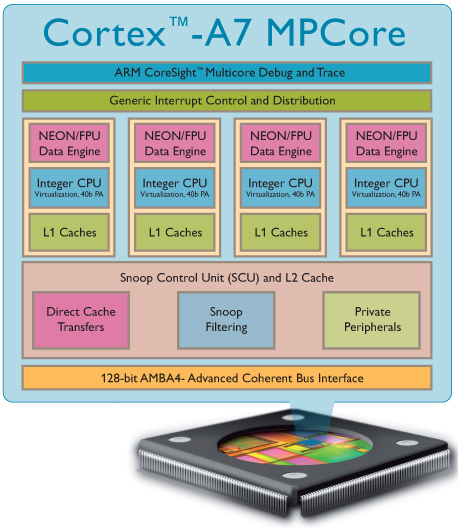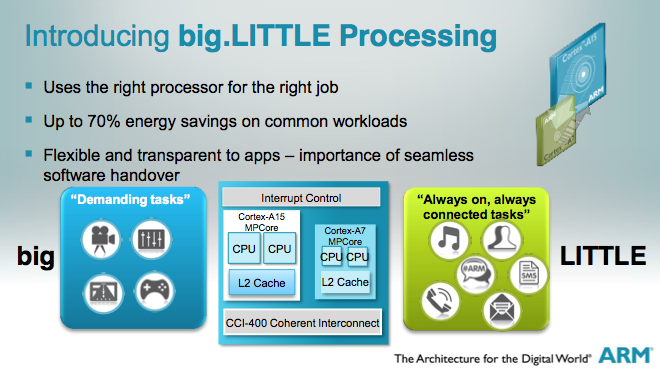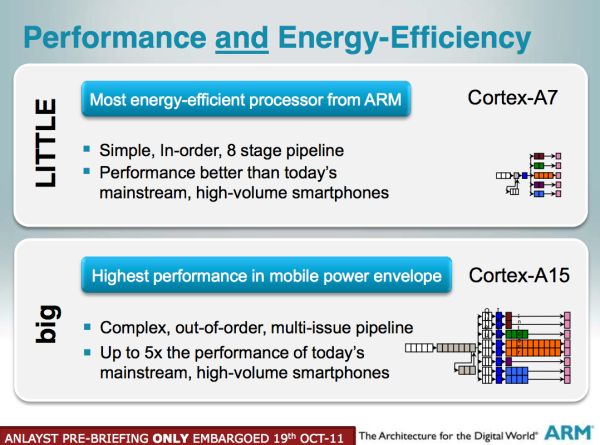ARM has launched the Cortex-A7 MPCore processor, which is aid to be the most energy efficient application class processor it has yet developed and the part features big.LITTLE processing, described as a flexible approach that redefines the traditional relationship between power and performance. ARM claims that the A7 will double the performance of its existing Cortex A8 family through a combination of process shrinks and improvements at the level of microarchitecture, A7′s design improvements over the older A8 core are possible because ARM has had the past three years to carefully study how the Android OS uses existing ARM chips in the course of normal usage. The single-core chip was designed for use in budget-friendly smartphones that will be priced under $100 and the first smartphones to use the new chip are expected to hit the market in 2013……………….
ARM announced the ARM Cortex-A7 MPCore processor – the most energy-efficient application class processor ARM has ever developed and big.LITTLE processing – a flexible approach that redefines the traditional power and performance relationship. The Cortex-A7 processor builds on the low-power leadership established by the Cortex-A8 processor that is at the heart of many of today’s most popular smartphones. A single Cortex-A7 processor delivers 5x the energy-efficiency and is one fifth the size of the Cortex-A8 processor, while providing significantly greater performance. The Cortex-A7 processor will enable a rich user experience in sub-$100 entry level smartphones and help connect the next billion people in developing markets. One of today’s technology most significant challenges is how to create a System on Chip (SoC) that meets the conflicting consumer demand for devices with both higher-performance AND extended battery life. Big.LITTLE processing, enabled by Cortex-A7, achieves this by pairing the best of the high-performance Cortex-A15 MPCore and ultra-efficient Cortex-A7 processors. Big.LITTLE processing allows devices to seamlessly select the right processor for the right task, based on performance requirements. Importantly, this dynamic selection is transparent to the application software or middleware running on the processors. ARM Partners supporting these technologies include Broadcom, Compal, Freescale, HiSilicon, LG Electronics, Linaro, OK Labs, QNX, Red Bend, Samsung, Sprint, ST-Ericsson and Texas Instruments. Mobile usage has changed significantly and today consumers are increasingly using their smartphone for the majority of their connected lives. This includes high-performance tasks, such as web browsing, navigation and gaming, and less demanding ‘always on, always connected’ background tasks, such as voice calls, social networking and email services. As a result, the mobile phone has become an indispensable compute device for many consumers.
At the same time, new mobile form factors, such as tablets, are redefining computing platforms in response to consumer demand. This is creating new ways for consumers to interact with content and brings what was once only possible on a tethered device to the mobile world. By developing big.LITTLE processing and the Cortex-A7 processor, ARM has addressed the challenge for technology that can deliver both high-performance, required for content creation and consumption, while also delivering extreme power efficiency for extended battery life. This is particularly pertinent as smartphones and tablets continue to evolve into the primary platforms that consumers use to interact with our increasingly connected world. The efficiency of the ARM architecture is the reason why ARM processors use less power and occupy a smaller footprint. The Cortex-A7 processor occupies less than 0.5mm2, using 28nm process technology, and provides compelling performance in both single and multicore configurations. Used as a stand-alone processor, the Cortex-A7 will deliver sub-$100 entry level smartphones in the 2013-2014 timeframe with an equivalent level of processing performance to today’s $500 high-end smartphones. The ARM vision of the entry level smartphone market is to redefine usage in the developing world by helping connect the next billion people to Internet content and services over mobile devices.
Big.LITTLE processing combines two different, but compatible processors within the same SoC and allows the power management software to seamlessly select the right processor, or multiple processors, for the right task. The processors appear identical from an applications software perspective. The ‘LITTLE‘, lowest-power processor – in this case, the Cortex-A7 – runs the Operating System (OS) and applications for basic always-on, always connected tasks, such as social media and audio playback. The OS and apps can then be seamlessly migrated to the higher-performance processor as demands increase for high end tasks, such as navigation and gaming. The time for this migration is in the order of 20 microseconds. This flexible approach of choosing the right processor for the right job enables highly optimized processing which results in significant energy savings for common workloads. The efficient and seamless switching of workloads between the two processors is supported by advanced ARM system IP, such as AMBA 4 ACE Coherency Extensions. This ensures full cache, I/O and processor-to-processor coherency between the Cortex-A15 and Cortex-A7, and across the complete system. Software and applications can therefore continue to run unhindered, and unnoticed by the user, as the tasks are rebalanced to provide the optimum big.LITTLE user experience. Big.LITTLE power management software is developed by ARM ecosystem partners months ahead of silicon availability using ARM DS-5 tools and Fast Model virtual prototyping technology. The virtual platform, available now to lead partners, contains the Cortex-A15 and Cortex-A7 processors, as well as cache coherent interconnect System IP, allowing full system software development.
[ttjad keyword=”processor”]






